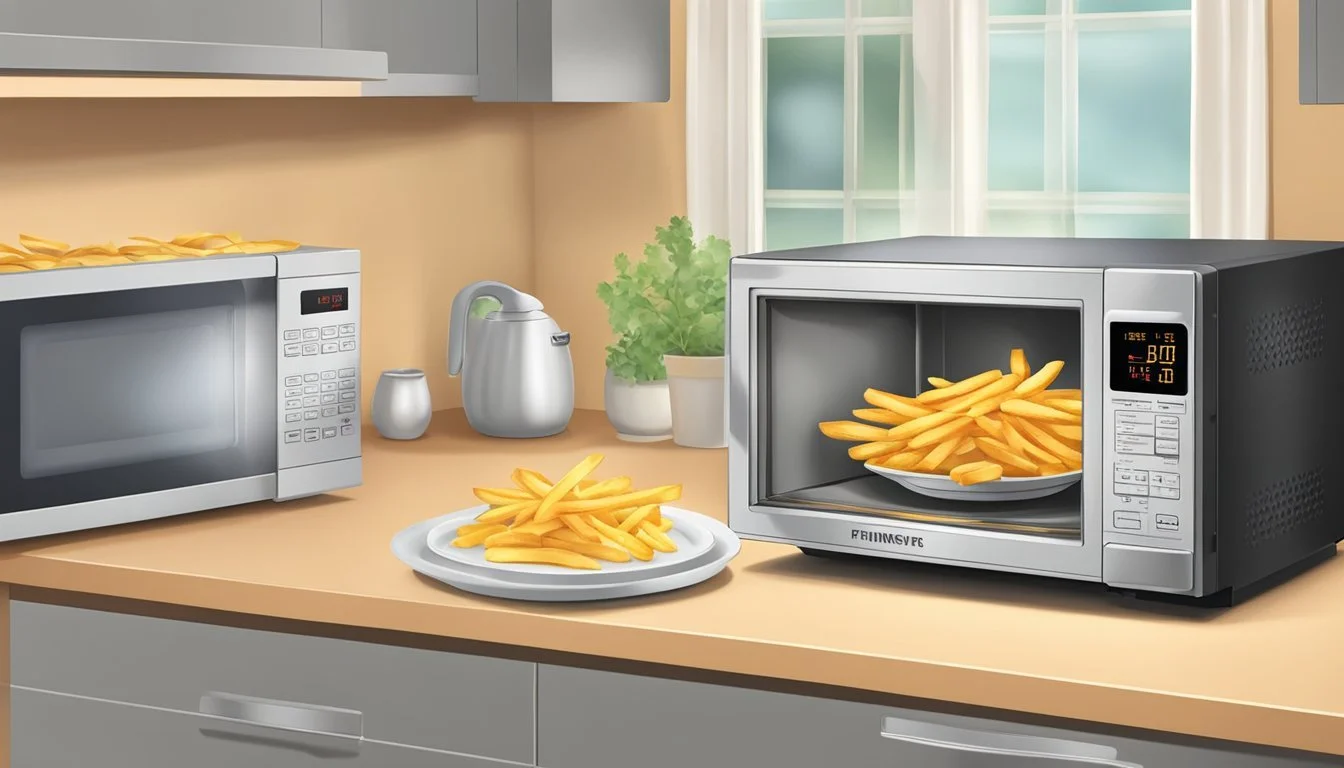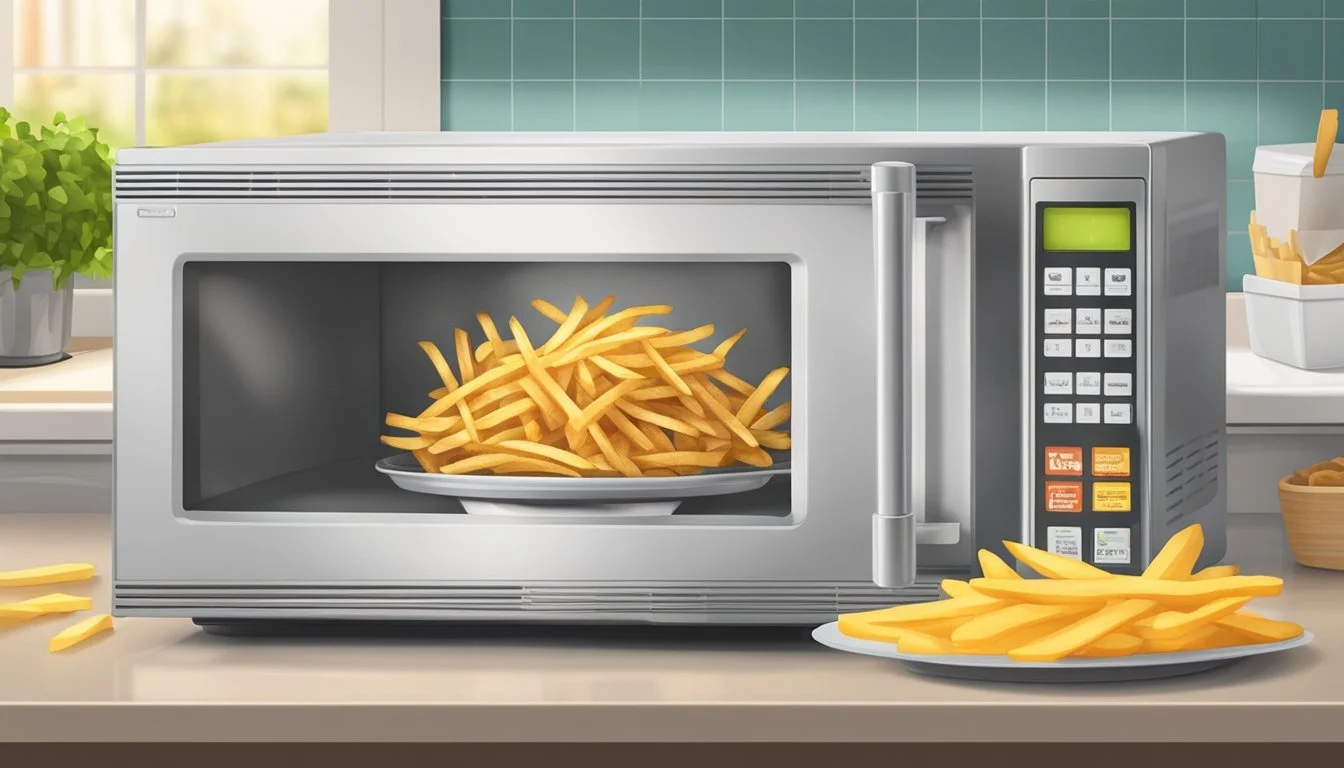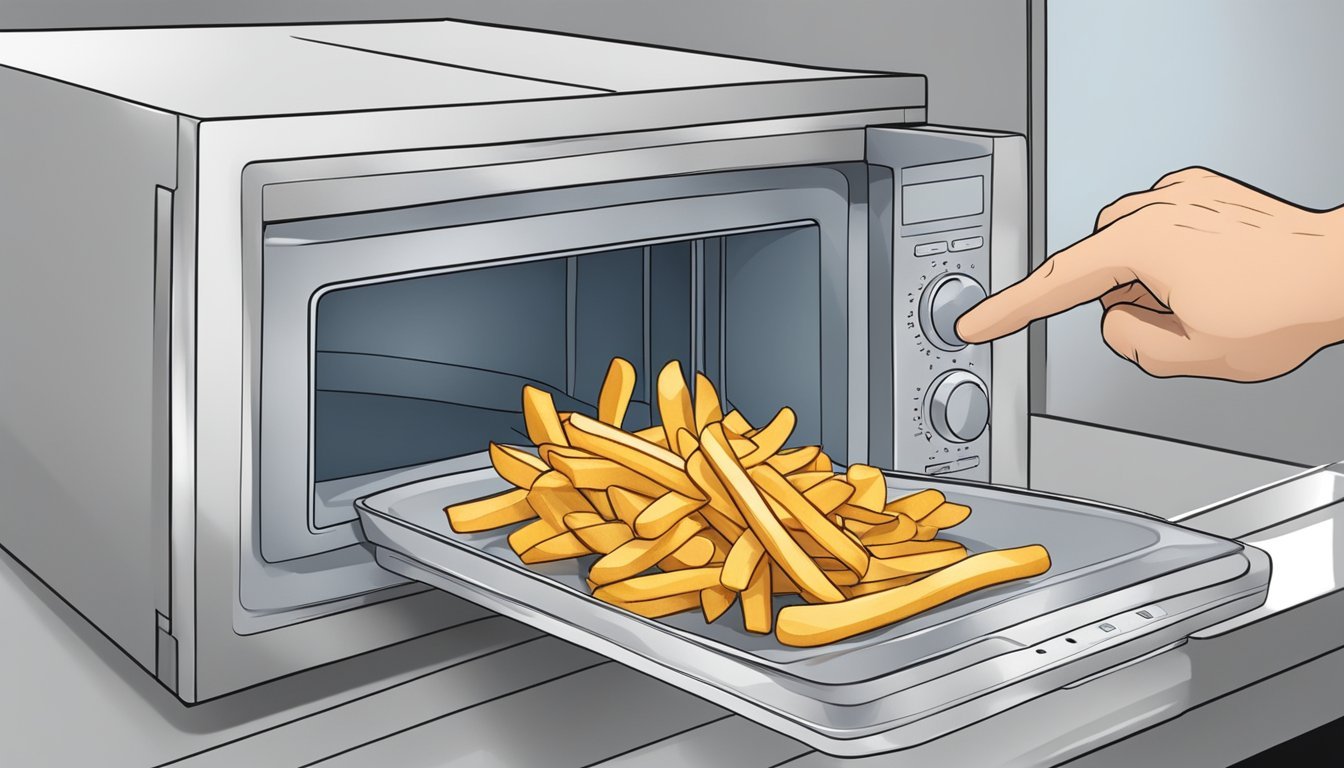How to Reheat French Fries Perfectly for Optimal Crispness
Reheating French fries doesn't have to be a culinary challenge. Whether you're using a stovetop, oven, or air fryer, there's a method that fits your needs. One of the best ways to reheat French fries is in the oven at 450 degrees Fahrenheit for 2-3 minutes. This high-heat method helps to restore the fries' original crispy exterior and warm interior.
For those who prefer a stovetop approach, heating a cast-iron skillet with a couple of tablespoons of oil over medium-high heat can also yield excellent results. By spreading the fries in a single layer and flipping occasionally, the fries can regain their delicious texture without needing to be submerged in oil.
An air fryer is another highly effective option. Taking about 8 minutes including preheating time, the air fryer uses minimal additional oil while consistently achieving a perfect crispy outcome. This method is particularly praised for its efficiency and convenience.
Understanding Reheating Fundamentals
Reheating French fries can be challenging due to their specific texture requirements. The primary goal is to restore their crispy exterior while ensuring the interior remains fluffy. Properly reheated fries should not be soggy or dry.
Different reheating methods can impact the final texture. Using an oven or air fryer can achieve the ideal crispy texture since these methods help maintain the right moisture balance.
Methods of Reheating and Their Effects
When using an oven:
Preheat to 400°F.
Spread fries evenly on a baking sheet.
Bake for 10-15 minutes until crisp.
In a microwave:
Set on high for 30 seconds to 1 minute.
Check for crispiness.
If not crispy, consider finishing in a toaster oven.
Tips for Optimal Results
Avoid overcrowding: Ensures even heating.
Use a rack: Lifts fries, allowing hot air to circulate.
Add oil: Lightly coat fries to enhance crispiness.
Considerations for Different Fry Types
Skinny fries: Require less time.
Thicker fries: Need additional heating but should be checked frequently to avoid drying out.
Maintaining Moisture Balance
Fries can become soggy if not reheated properly. Techniques like patting fries dry before reheating help remove excess moisture. For crispy results, opt for methods that involve consistent, dry heat.
By understanding these fundamentals, achieving that perfect balance between a crispy outside and a fluffy inside becomes simpler, making for delicious reheated French fries.
Preparation Before Reheating
Proper preparation ensures that leftover French fries regain their optimal taste and texture. Key factors include selecting the right fries to reheat and correctly storing leftovers.
Choosing the Right Fries to Reheat
Not all French fries are created equal, and this matters when reheating. Thick-cut fries often retain their texture better than thin-cut ones. Seasoning also impacts reheating; fries with salt, pepper, garlic powder, or paprika can offer more flavor post-reheating.
Freshly made fries stored properly have a better chance of tasting great when reheated. Avoid old, soggy fries which tend to deteriorate in taste and texture. Consider the type of oil used for frying as well; vegetable oil or oils with a high smoke point are preferable.
Reheating fries with added toppings such as bacon or cheese should be done with care to prevent the toppings from burning or becoming too hard. Checking the state of the fries before reheating can make the difference between a crunchy delight and a mushy mess.
Storing Leftover French Fries
Proper storage is essential to preserve the quality of leftover French fries. Store fries in an airtight container to limit exposure to air and bacterial growth. This method maintains the texture and prevents fries from becoming stale.
Leftover fries should be refrigerated within two hours of cooking to prevent bacteria, ensuring they remain safe for later consumption. When possible, avoid storing fries with excess moisture or grease, as these can make the fries soggy.
Before placing them in the refrigerator, ensure the fries are completely cool. Layer paper towels between the fries to absorb excess oil and moisture. If frozen, fries should be thawed properly before reheating to maintain their structure.
Correct storage preparation can significantly influence the reheating results, leading to crispy, tasty French fries that are a joy to eat even days after they were first made.
Reheating Methods
Discover the best ways to reheat French fries to enjoy them hot and crispy. Each method offers unique advantages and tips to suit different preferences in texture and preparation time.
Using an Oven or Toaster Oven
Preheating the oven or toaster oven to around 400 to 450 degrees Fahrenheit is essential for reviving French fries. Spread the fries evenly on a baking sheet lined with aluminum foil to prevent sticking and make cleanup easier.
Place the fries in a single layer to ensure they crisp up evenly. Bake for approximately 8-10 minutes. Toss halfway through if you want them extra crispy. This method helps achieve a golden, crunchy exterior while preserving the inside's fluffy texture.
Microwave Method: Pros and Cons
The microwave offers a quick way to reheat fries, but the results can vary. Place the fries on a microwave-safe plate in an even layer. Microwave in 30-second bursts to monitor the heat and prevent sogginess.
While this method is convenient, it often results in less crispy fries compared to other methods. Microwaving can make fries hot but may also render them slightly soggy. It's best used when time is short, and crispy texture is less of a priority.
Getting the Best Results with an Air Fryer
An air fryer can bring French fries back to life with minimal oil. Preheat the air fryer to about 350 degrees Fahrenheit. Place the fries in the basket in an even layer to ensure they reheat uniformly.
Cook for 3-5 minutes, shaking the basket halfway through. This method excels in delivering hot, crispy fries without the need for additional oil, making it a healthier option. The result is a deliciously crunchy texture similar to freshly fried fries.
Stovetop Skillet Technique
Reheating fries on a stovetop skillet preserves their crispy exterior. Heat a small amount of oil in a skillet over medium heat until it’s hot but not smoking. Spread the fries in an even layer on the skillet.
Cook for about 3-5 minutes, tossing occasionally to ensure they heat evenly and develop a crisp surface. This method is effective for adding extra crunch to the fries while maintaining their delicious taste.
Deep Frying to Refry
Using a deep fryer to reheat fries can restore their original crispy state. Heat oil (vegetable, canola, or peanut) to about 350 degrees Fahrenheit. Submerge the fries in hot oil for 2-3 minutes.
Drain on paper towels to remove excess oil. This method delivers extremely crunchy fries, though it involves more preparation and cleanup. It is best for those seeking the taste and texture of freshly fried fries.
Additional Tips for Enhanced Flavor and Texture
Enhancing the flavor and texture of reheated French fries can be achieved by adding seasonings and pairing them with complementary foods. These methods will elevate your dish and make it even more enjoyable.
Seasoning After Reheating
After reheating, seasoning is key to reviving flavor. Adding salt and pepper is fundamental, but other seasonings can boost taste and crispness. Truffle oil can add a gourmet touch, while garlic powder and paprika provide savory depth.
Consider sprinkling a pinch of paprika for a smoky flavor or garlic powder for an aromatic twist. Drizzling some truffle oil over the fries adds a luxurious flair and enhances their crispiness. For loaded fries, additional toppings like grated cheese and bacon bits can also be applied at this stage, making them even more delightful.
Complementary Foods and Recipes
Pairing French fries with other dishes can create a balanced and flavorful meal. Poutine, which combines fries with gravy and cheese curds, is a beloved option. The gravy adds richness, and the cheese curds provide a pleasing texture contrast.
Fries make an excellent side for breakfast dishes too. Incorporate them into a breakfast hash with eggs, sausage, and vegetables.
Try serving freshly reheated fries with a variety of dips, from classic ketchup to spicy aioli, to add another layer of flavor. For those who enjoy a hearty meal, consider making loaded fries with toppings such as chili, shredded cheese, and sour cream.
Safety Considerations
When reheating French fries, proper safety precautions are crucial.
Always ensure that the fries are reheated thoroughly. Inadequate reheating can leave them in the temperature "danger zone" (40°F to 140°F), where bacteria thrive.
Oil management is important too. Fries should be free of excess oil to avoid the risk of oil splattering and potential burns.
Preheating appliances such as ovens and toaster ovens to the recommended temperatures ensures consistent and safe reheating.
Care should be taken to use heat-resistant gloves or mitts when handling hot baking sheets or trays.
Never leave cooking appliances unattended. Stay close to monitor the heating process to avoid overheating and burning.
Ensure the kitchen has proper ventilation to avoid buildup of heat and potential fumes from oils.
Avoid reheating fries that have been sitting out for more than 2 hours at room temperature. This minimizes the risk of bacteria growth and foodborne illness.
Lastly, always remember to clean any kitchen surfaces and utensils that came into contact with cold fries or oil to maintain hygiene and reduce contamination risks.
Reheating Leftovers for Different Occasions
Reheating leftovers can transform them into a fresh, delicious meal. Whether it’s for a quick snack, a family dinner, or a party, knowing the best methods is key.
For a quick lunch or snack, reheat fries in an air fryer. Preheat for a few minutes, then heat the fries for about 8 minutes. This method ensures they remain crispy with minimal oil.
For a family dinner, utilize the oven. Preheat to 425°F, spread the fries evenly on a parchment-lined baking sheet, and heat for 8-10 minutes. This method is perfect for larger quantities, maintaining the fries' crispiness.
When preparing for a party, a skillet works well. Turn the burner to medium-high, spray with cooking spray, and keep flipping the fries for around 3 minutes. This technique adds a crispy texture, making fries an inviting appetizer.
For a gathering with friends, consider using the toaster oven. Preheat to 400°F, line a tray with aluminum foil, and heat the fries for about 5-7 minutes. This ensures an even, crunchy texture, ideal for sharing.
Summary of Methods
Occasion Method Time Temperature Quick Lunch/Snack Air Fryer 8 minutes Preheat briefly Family Dinner Oven 8-10 minutes 425°F Party Skillet ~3 minutes Medium-high heat Gathering Toaster Oven 5-7 minutes 400°F
By using these methods, reheated leftovers, particularly fries, can be enjoyed at their best, no matter the occasion.
Cleanup and Maintenance
Cleaning up after reheating French fries is simple if done correctly. Begin by ensuring all appliances are off and cool before starting the cleanup to maintain safety.
When using an oven, line the baking sheet with aluminum foil before heating the fries. This prevents grease and crumbs from sticking, making it easier to clean. Once done, discard the foil for a quick cleanup.
If a baking sheet was used without foil, allow it to cool, then use a spatula to gently scrape off any remaining bits. Wash the sheet with warm, soapy water or place it in the dishwasher if it’s dishwasher-safe.
For those using a microwave, clean the plate or bowl used. A moist cloth can be employed to wipe down the inside of the microwave, especially if any oil splatters or food residues are present. This helps maintain the appliance in good working condition.
In case of using a stovetop with a pan, wipe any oil splashes around the stove area. Also, clean the pan by removing excess oil with a paper towel before washing it with dish soap and water.
Always prioritize safety by checking that there are no lingering hot surfaces or utensils before starting the cleanup. This helps prevent burns or other accidents. Following these steps ensures a straightforward and efficient cleanup process.





